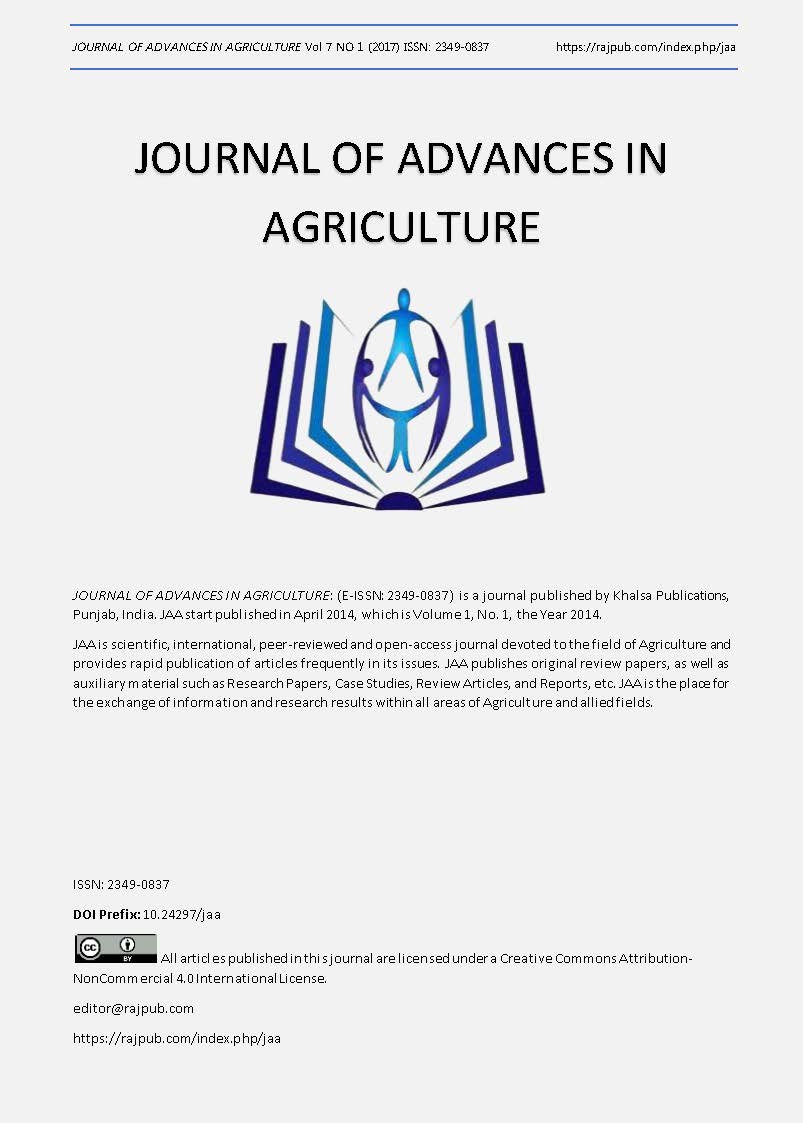MOLECULAR CLONING, PROKARYOTIC EXPRESSION AND PREPARATION OF ANTISERUM AGAINST LILY SYMPTOMLESS VIRUS TGB1 PROTEIN
DOI:
https://doi.org/10.24297/jaa.v7i1.5794Keywords:
antiserum preparation, cloning, expression, Lily symptomless virus, TGB1 geneAbstract
The triple gene block gene TGB1 was amplified by RT-PCR from lily leaves infected with Lily symptomless virus and cloned into prokaryotic expression vector pET-28a(+). The recombinant vector was transformed into Escherichia coli strain BL21 (DE3). On induction with isopropyl β-D-1-thiogalactopyranoside,TGB1 protein was highly expressed and the molecular weight was 29 kDa (including a His-tag-containing fusion). After protein purification by Ni2+-NTA affinity chromatography, a polyclonal antibody against TGB1 was raised in mouse. Western blot analysis showed that the antiserum reacted specially with the TGB1 protein of LSV. ELISA and RT-PCR confirmed that the antiserum reacted specially with lily leaves infected with LSV, and can be used for a rapid test for LSV. The antibody produced in this work may be used for future immunohistochemistry and functional study of TGB1.
Downloads
References
2. Asjes CJ. 2000. Control of aphid-borne Lily symptomless virus and Lily mottle virus in Lilium in The Netherlands. Virus Res, 711:23–32.
3. Bosque-Pérez N.A., Thresh J.M., Jones R.A.C., et al.2014. Ecology, evolution and control of plant viruses and their vectors. Virus Research, 186:1-2.
4. Diaconescu M, Hoza D, Ion L.2013. Serological ELISA test of some black currant and red currant cultivars. Journal of Horticulture Forestry & Biotechnology,17(4): 36- 38.
5. Jia H, Zheng J, Meng Q.J., et al.2014. Detection of Two Kinds of Aphids Carried LSV,TMV with DNA Microarry. Acta Agriculturae Boreali-Sinica, 29(1):20-24.
6. Pin-San X.U., Wen-Xia L, Xia X.Y., et al.2012.Cloning and sequences analysis of the complete genome of Dalian isolate of Lily symptomless virus. Acta Phytopathologica Sinica,42(6):641-644.
7. Singh A.K, Mahinghara B.K., Hallan V,et al.2008.Recombination and phylogeographical analysis of Lily symptomless virus. Virus Genes, 36(2):421-427.
8. Tavasoli M, Shahraeen N, Ghorbani S.2009. Serological and RT-PCR detection of cowpea mild mottle carlavirus infecting soybean. Journal of General & Molecular Virology, 1(1):7-11.
9. Wang R.Y., Wang G.P., Zhao Q, et al.2010.Expression, purification and characterization of the Lily symptomless virus coat protein from Lanzhou Isolate . Virology Journal, 7(1):1.
10. Xu Pin-san, Li Huan-gai, Liu Ji-wen, Luan Yu-shi, Yin Ya-lei, Bai Jian-fang.2011.Sequence and structure prediction of RNA-dependent RNA polymerase of lily symptomless virus isolated from L.‘Casablanca’. Arch Virol,156(6): 939–943.
11. WU Qi-Yao.2013.Prokaryotic Expression of TFMV,FVY and LMoV CP Gene,Antiserum Preparation and Virus Detection. Bulletin of Botanical Research, 33(1):73-79.
12. Zhang Y, Wang Y, Jing M, et al .2015. Development of an immunochromatographic strip test for rapid detection of lily symptomless virus. Journal of Virological Methods, 220:13–17.
Downloads
Published
How to Cite
Issue
Section
License
 All articles published in Journal of Advances in Linguistics are licensed under a Creative Commons Attribution 4.0 International License.
All articles published in Journal of Advances in Linguistics are licensed under a Creative Commons Attribution 4.0 International License.




